Beware of troubles when using metal tire chains; Slack in chains or over speed may cause breakage of chains and unexpected accident
Purpose
In order to safely drive a car on a snowy or icy road, non-slip tire chains are mounted on car tires. These chains are roughly divided into two types: metal chains and non-metal chains. The ground contact area of metal tire chains is made from metal, while that of non-metal chains is made from urethane, rubber, etc. Last fiscal year, about 400,000 pairs of metal tire chains and about 240,000 pairs of non-metal tire chains were sold in Japan. 1 Therefore, metal tire chains were sold far more than non-metal tire chains.
PIO-NET 2 received 89 inquiries 3 related to safety and quality of tire chains (inclusive of both metal and non-metal chains), which included 57 inquiries from the Southern Kanto region (64.0%). The percentage was quite large in light of the ratio of population in the region, which is about 28%. Probably this is because roads in this region are seldom covered with snow even in winter, and drivers with less experience of using tire chains suddenly have to use them when it snows.
In the last five years, NCAC's Product Test Department received four requests for a product test on fracture of metal tire chains while driving because car accidents occurred due to broken metal tire chains (e.g. cars damaged by broken chains, cars bumping against a snow wall due to a brake problem). As a result of the product test, some products showed insufficient strength or poor welding.
NCAC conducted a questionnaire survey about use of metal tire chains among consumers with an aim to inform precautions to safely use metal tire chains.
- 1 Feature article on winter items on page 45-49, the October 2016 issue of "Gekkan Ahutah Mahketto" published by Jidousha Shinbunsha
- 2 PIO-NET (Practical Living Information Online-Network System) is a database that collects information on inquiries concerning consumer affairs by linking the National Consumer Affairs Center of Japan with local consumer centers and similar organizations across Japan via an online network. Inquiries referred from local consumer centers, etc. are not included since FY2015.
- 3 Data registered through December 31, 2016
Period of investigation
- Period of purchasing specimens: January-February 2016
- Period of investigation: October-December 2016
Types of metal tire chains
Metal tire chains are roughly divided into two types: those in ladder pattern and those in honeycomb-like pattern (See Photo 1). Those in ladder pattern have chains crossed over the tread surface of the tire (so called "cross chains") and have good grip in the front-back direction. Those in honeycomb-like pattern have chains in the longitudinal direction and the oblique direction on the tread surface of the tire (so called "cross chains" or "tread chains") and have good grip in the front-back direction as well as the lateral direction. Incidentally, there is a Japanese Industrial Standard (JIS) for ladder pattern tire chains. The JIS specifies the size, hardness, and tensile strength thereof. There is no JIS for honeycomb-like pattern tire chains.
Photo 1: Examples of metal chains
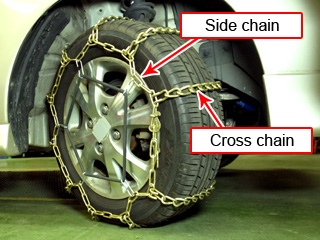
Ladder pattern
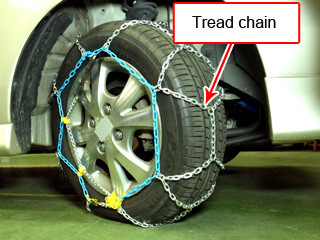
Honeycomb-like pattern
Sample cases of inquiries received by PIO-NET
According to inquiries and complaints about safety or quality of metal tire chains received by PIO-NET, some chains were broken while driving, and the broken chains sometimes damaged the car body.
- [Case1]
- I borrowed tire chains from my friend and applied them to winter tires before driving a car. The chains were new, and it was the first time for me to use tire chains. When I was driving home at 40 km/h or more, the chain on the left front tire was broken. The broken chain beat and damaged the bumper. I was told that the repair cost would be around 250,000 yen. I made a complaint to the seller of the chains and asked for investigation.
The seller told me that there was no problem in quality thereof and that the incident had been caused by improper use. - (received in January 2012, woman in her 60s in Saitama)
- [Case2]
- I bought metal tire chains at a shop along a highway on the way to a snowy mountain. Soon after driving with the new chains, they were broken and wheels were scarred. I was told the repair cost would be 70,000 yen. I made a complaint to the seller and handed the actual product to be investigated by the manufacturer. They told that the cause was considered to be excessive speed, long distance drive, or tire spinning out.
- (received in January 2015, woman in her 30s in Osaka)
- [Case3]
- After driving with new tire chains 5 km on a snowy road, the chains broke and damaged my car. I asked the seller for investigation of the defect. Later, they reported me that the chains had been overloaded due to sudden acceleration or sudden braking. I am dissatisfied with the report.
- (received in February 2016, man in his 40s in northern Kanto)
Questionnaire survey
NCAC investigated actual use of metal tire chains through a questionnaire survey among 457 consumers who had used metal tire chains in the last five years.
About 60% of respondents bought metal tire chains to be prepared for any needs.
When asked about reason for purchase, 282 respondents (61.7%) answered "I bought to be prepared without plan to use", while 109 respondents (23.9%) answered "I bought beforehand with plan to use".
Diagram 1: Reason for purchasing metal tire chains
(n=457)
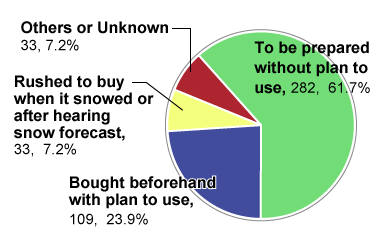
Those who bought to be prepared without plan to use amounted to 282 (61.7%). Those who bought beforehand with plan to use amounted to 109 (23.9%). Those who rushed to buy when it snowed or after hearing snow forecast amounted to 33 (7.2%). Other or unknown cases amounted to 33 (7.2%).
About 40% of respondents encountered any trouble during use. The most common trouble was "chain loosened while driving", followed by "chain broken while driving".
Among 457 respondents, 184 (40.3%) encountered any trouble during use. Those who encountered loosened chains while driving amounted to 81 users (44.0%). Those who encountered broken chains while driving amounted to 68 users (37.0%). (See Diagram 2)
Diagram 2: Troubles when using tire chains
(n=184; multiple answers allowed)
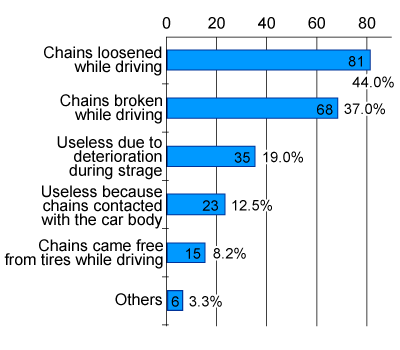
Cases where chains were loosened while driving amounted to 81 (44.0%). Cases where chains were broken while driving amounted to 68 (37.0%). Cases where chains were useless due to deterioration during storage amounted to 35 (19.0%). Cases where chains were useless because applied chains contacted with the car body amounted to 23 (12.5%). Cases where chains came free from tires while driving amounted to 15 (8.2%). Other cases amounted to 6 (3.3%).
More than 20% of those who answered "chains loosened" or "chains broken" encountered any damage on the car body, etc.
Among 184 respondents who encountered any trouble, those who encountered "chains loosened" or "chains broken" amounted to 136 (overlap excluded). Those who encountered damage on the car body, etc. caused by loosened or broken chains amounted to 35 (25.7%; overlap excluded). The most common damage was "car body or wheels severely damaged". (See Diagram 3)
Diagram 3: Damage when chains were loosened or broken
(n=136; multiple answers allowed)
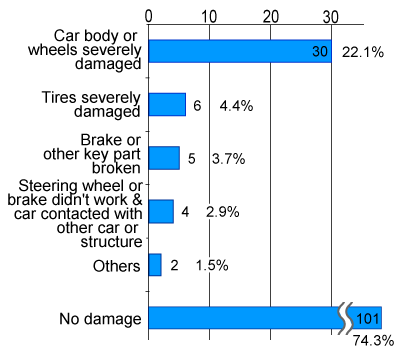
Cases where the car body or wheels were severely damaged amounted to 30 (22.1%). Cases where tires were severely damaged amounted to 6 (4.4%). Cases where the brake or other key part was broken amounted to 5 (3.7%). Cases where the steering wheel or brake didn't work and the car contacted with other car or structure amounted to 4 (2.9%). Other damage cases amounted to 2 (1.5%). No damage cases amounted to 101 (74.3%).
When chains were loosened or broken, about 40% of respondents were driving at over 30 km/h.
Among those who encountered loosened or broken chains, 52 respondents (38.2%) were driving at over 30 km/h when the trouble occurred.
Diagram 4: Traveling state when chains were loosened or broken
(n=136; multiple answers allowed)
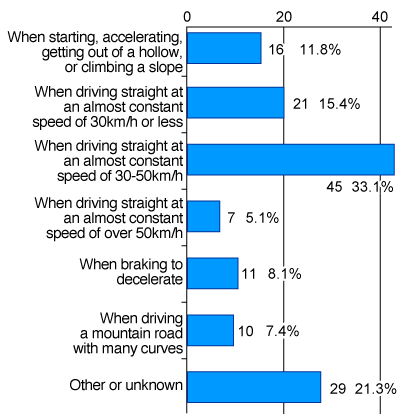
Chains were loosened or broken when starting, accelerating, getting out of a hollow, or climbing on a slope in 16 cases (11.8%). Chains were loosened or broken when driving straight at an almost constant speed of 30km/h or less in 21 cases (15.4%). Chains were loosened or broken when driving at an almost constant speed of 30-50km in 45 cases (33.1%). Chains were loosened or broken when driving at an almost constant speed of over 50km/h in 7 cases (5.1%). Chains were loosened or broken when braking to decelerate in 11 cases (8.1%). Chains were loosened or broken when driving a mountain road with many curves in 10 cases (7.4%). Other or unknown cases amounted to 29 (21.3%).
When chains were loosened, about 70% of respondents were driving on a snowy or icy road. When chains were broken, about 50% of respondents were driving on an asphalt road.
Considering the difference of road surface conditions between when chains were loosened and when chains were broken, NCAC accumulated data in each individual case. The data showed that 54 out of 81 respondents who encountered loosened chains (66.7%) were driving on a snowy or icy road, while 31 out of 68 respondents who encountered broken chains (45.6%) were driving on an asphalt road (See Diagram 5).
Diagram 5: Road surface conditions when trouble occurred
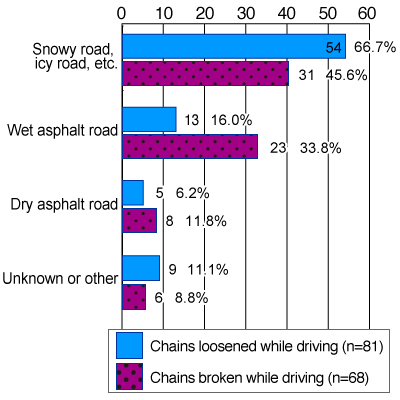
When chains were loosened: 54 respondents (66.7%) were driving on a snowy or icy road, etc.; 13 respondents (16.0%) were driving on a wet asphalt road; 5 respondents (6.2%) were driving on a dry asphalt road; unknown or other cases amounted to 9 (11.1%). When chains were broken: 31 respondents (45.6%) were driving on a snowy or icy road, etc.; 23 respondents (33.8%) were driving on a wet asphalt road; 8 respondents (11.8%) were driving on a dry asphalt road; unknown or other cases amounted to 6 (8.8%).
When respondents encountered loosened or broken chains, the travel distance of more than 70% of them was less than 100 km (See Diagram 6).
When either of the two troubles occurred, the travel distance was less than 100 km in 99 cases (72.8%).
Diagram 6: Travel distance when chains were loosened or broken
(n=136; multiple answers allowed)
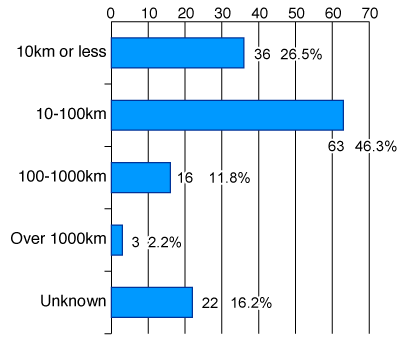
When chains were loosened or broken, the travel distance was: 10 km or less in 36 cases (26.5%); 10-100 km in 63 cases (46.3%); 100-1000 km in 16 cases (11.8%); over 1000 km in 3 cases (2.2%); unknown in 22 cases (16.2%).
Test cases of metal tire chains
The following shows test cases of metal tire chains in response to requests from local consumer centers, etc. Consultation for these cases based on the test results finished.
(1) Product test case 1
When I was driving on a snowy highway, tire chains were broken and the broken chains damaged the fender. The seller did not respond to the problem, saying that the incident had been caused by over speed. I am dissatisfied with the seller's attitude.
(received in January 2012, man in his 40s in Kanagawa)
Product test results
The product concerned was worn away all over probably due to friction against the road. In the most damaged area, the chain decreased in thickness to one third or so. (See Photo 2)
Photo 2: Abraded tread chains concerned
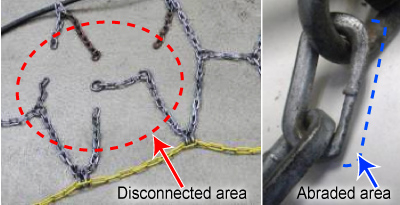
The abraded area of the tread chains was investigated to check the attachment condition. The chain was more densely applied to the outer side, but it was considered that there had been no problem in the attachment to tires.
Although the chains concerned were in honeycomb-like pattern and not covered by the JIS, the JIS was used as a reference to investigate hardness of the chain. As a result, it was found that the chain was softer than standard hardness and that hardness was varied between links, which means being prone to abrasion.
With regard to precautions about chain disconnection, the instruction manual stated precautions about driving speed, but there was no label indicating the precautions on the package box.
(2) Product test case 2
When I went to a ski area, I applied chains to tires and drove my car. I put on the brake at the left curve, but the chains were disconnected and the brake did not work. I bumped against a snow wall. The bumper was cracked. The tire house was also damaged. The head light was broken.
(received in May 2012, man of unknown age in Osaka)
Product test results
As a result of appearance check of the product concerned, it was found that tread chains thereof had many poor welding spots. (See Phot 3)
Photo 3: Poor welding on tread chains
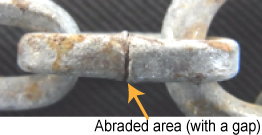
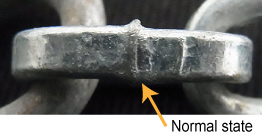
Abraded areas of the tread chains were examined to check the attachment condition. The tread chains on both right and left sides were worn out around the center. It was considered that there had been no problem in the attachment to tires.
Although the chains concerned were in honeycomb-like pattern and not covered by the JIS, the JIS was used as a reference to investigate hardness of the chain. As a result, it was found that the chains were softer than standard hardness, which means being prone to abrasion. In addition, the tensile strength was low.
Hardness test based on JIS and visual check of welded parts
As a result of examining metal tire chains of 12 brands currently sold in the market, hardness of links was harder than the standard hardness specified by the JIS. Poor welding was not observed.
In the product test conducted by NCAC in response to requests from local consumer centers, etc., some tire chains were broken probably due to poor welding or lack of strength.
Therefore, NCAC examined metal tire chains of 12 brands sold at an auto-supply shop and a home center in Sagamihara city to see if they have enough strength and if there is any problem in welded parts thereof.
In the product test case 2, some tire chains were broken probably because abrasion developed earlier due to lack of strength of cross chains (or tread chains; at the ground contact area when in use). Therefore, NCAC investigated hardness of chain links, which might influence abrasion tendency. The Japanese Industrial Standard D4241 "Road vehicle - Tire chains" specifies that the surface of cross chains for metal tire chains in ladder pattern should have Rockwell hardness 4 76 HRA or more (wire diameter: 5mm). Accordingly, hardness in the vicinity of surface of three links taken from each brand cross chain was measured by a micro-Vickers hardness 5 tester. The values were converted into Rockwell hardness values.
As a result, the values varied from 77.2 to 83.2 HRA (average: 81.0 HRA), which are larger than the JIS value. So, hardness of all the brand products met the JIS. (See Table 1)
In the product test case 2, some chains had poor welding. As a result of visual check, defects including poor welding were not found in the brand products tested this time.
- 4 Under the test method, an indenter is pushed against the surface of a sample. The Rockwell hardness number is calculated from the depth of permanent deformation of the indenter into the sample.
- 5 Under the test method, an indenter in the form of a pyramid with a square base is pushed against the surface of a sample. The micro-Vickers hardness number is calculated from the length of the diagonal of a square dent.
| Pattern | Minimum | Maximum | Average | Value of JIS |
|---|---|---|---|---|
| Ladder pattern (7 brands) |
77.2 | 82.6 | 80.6 | 76 or more |
| Honeycomb-like pattern (5 brands) |
79.5 | 83.2 | 81.7 | N/A |
| Overall (12 brands) |
77.2 | 83.2 | 81.0 | N/A |
Simulation test reproducing trouble cases
(1) When loosened chains are used
According to the questionnaire results, the most common trouble was "chains loosened while driving". Therefore, NCAC conducted a driving test when a rubber band as loose stopper (See Photo 4) and a hoist (See Photo 5) are misused, based on an assumption that chains were loosened while driving due to improper application of tire chains or broken loose stopper.
Photo 4: Rubber band
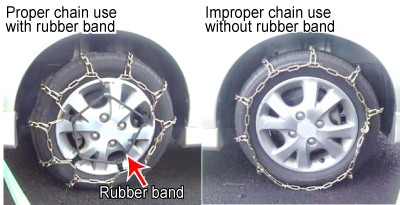
Photo 5: Tire chain hoist
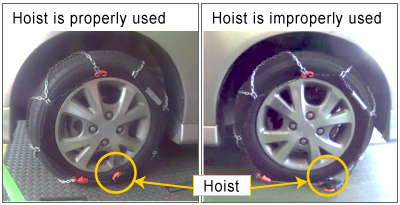
Jumping chains began to touch the car body, and they were slammed against the road.
In the product test, tire chains were jumping due to the centrifugal force even at the speed of 30 km/h, and the loose chains were slammed against the road (See Photo 6). These phenomena cause earlier abrasion. Since chain jumping and chain slamming are caused by the centrifugal force, a car may run idle if a driver presses an accelerator hard when the car is going to start moving or when tires are in deep snow.
Photo 6: Jumping chain slammed against the road (speed: 30km/h)
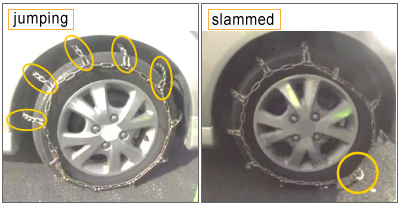
A tire chain almost coming off could accelerate abrasion and breakage, and also could wind around and damage the brake hose.
In some cases, loose tire chains jumped and were almost coming off (See Photo 7).
Photo 7: Jumping chain almost coming off (speed: 20 km/h)
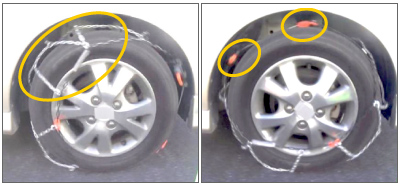
It is inferred that a chain almost coming off could accelerate abrasion and breakage of the chain, because side chains and cables, which should be on the lateral side of the tire, were on the ground contact area in the test (See Photo 8). Sometimes the chain might fall inside the wheel, and wind around and damage the brake hose.
Photo 8: Side chain & cable moved to the ground contact area of the tire
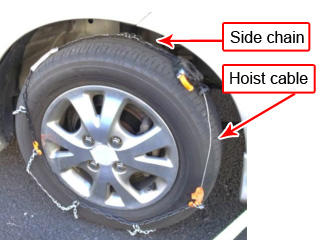
(2) Crash stop
It was inferred that a crash stop could greatly twist chains and apply a big load to chains.
When a crash stop was performed with tire chains mounted, chains were twisted between the tire and the road face even when rubber bands were used. When not using rubber bands, chains were more greatly twisted, so it was considered more load was applied to the chains (See Photo 9).
Photo 9: Crash stop
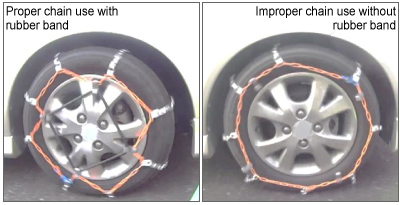
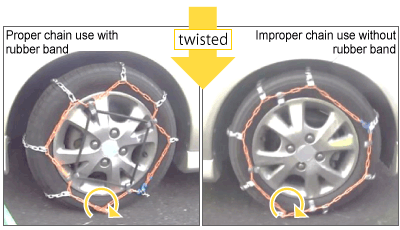
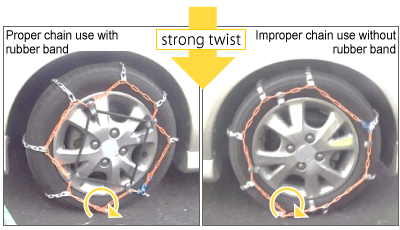
Descriptions on instruction manuals
NCAC checked instruction manuals for metal tire chains of 12 brands currently sold in the market. The instruction manuals described pre-practice for applying chains, key points to check slack in chains after applying, and key points to check abrasion.
NCAC checked precautions and other descriptions on instruction manuals for metal tire chains of 12 brands sold at an auto-supply shop and a home center in Sagamihara city. Almost all the 12 brands provided the following descriptions.
- Do a pre-practice before applying the chains, and check if there's any slack in chains after applying them (Be sure to check also after driving a few hundred meters at reduced speed).
- Keep the speed limit (safe speed is 30 km/h or less, although the speed limit is 50 km/h) and refrain from any sudden action such as sudden braking, abrupt steering and sudden acceleration as well as idle running.
- Unchain tires when driving non-snowy or non-icy asphalt roads.
- Observe chain abrasion and refrain from using if one third or half of the volume was abraded away, i.e. if its diameter is reduced to two third or half of the original one (See Diagram 7).
Diagram 7: Abrasion loss of chain links
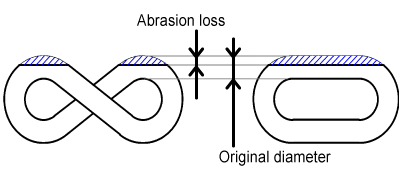
NCAC also observed descriptions such as "install chains on flat ground excluding roads", "check if the chain is not twisted when applying it", "in case of keeping the chain for a long period, wash it with water. After drying, apply rust-preventive agent to it".
Advice for consumers
Tire chains function as slip resistance for tires when driving snowy or icy roads. Driving with chains is different from normal driving with bare tires. In order to avoid troubles or accidents, beware of the following points when using tire chains.
(1) Learn how to apply tire chains beforehand. Practice it to be prepared. After applying them, make sure there's no slack in chains.
The questionnaire survey results showed that troubles when using tire chains were often associated with loosened chains. In the simulation test, loosened chains jumped and were slammed against the ground while driving. Misalignment of chains made when applying chains to tires will generate slack in chains while driving. If you keep driving with loosened chains or with improperly applied loose stopper, tire chains would be broken. Such broken chains might damage the car body and tires. Be sure to check the condition of chains after driving dozens or several hundred meters, even if you are on your way.
(2) Keep the speed limit and refrain from sudden actions while driving.
The speed limit when driving with metal tire chains is 30 km/h or less in general, although it depends on products. Some questionnaire respondents encountered troubles when driving at above 30 km/h.
In the simulation test, chains were greatly twisted and heavily loaded when a driver braked suddenly. Not only spinning out due to pressing hard on the accelerator when tires are in deep snow, but also driving at excessive speed, sudden acceleration, sudden braking, etc. could damage tire chains earlier, regardless of road conditions. Broken chains could damage the car body. Remember gentle start, gentle acceleration/deceleration, and gentle stop.
(3) Avoid driving with chains on non-snowy or non-icy asphalt roads.
According to the questionnaire results, troubles when driving with chains included breakage of chains. Broken chains could wind around the brake hose or could weaken the braking function, which may lead to a serious accident. Avoid driving with chains on non-snowy or non-icy asphalt roads, which often breaks chains. Apply or remove chains somewhere safe.
(4) Stop using chains with abnormality (e.g. excessive wear).
When NCAC conducted a product test in response to requests from local consumer centers, etc., some metal tire chains had quality problems, such as poor welding, softer material prone to abrasion, and so on. In the hardness test of the 12 brand products this time, no product lacked hardness. It is essential to check the condition of chains before using and to refrain from using those with abnormality (e.g. excessive wear).
Request to businesses concerned
NCAC requests businesses concerned to raise consumer awareness to ensure that users check slack in tire chains and drive safely.
According to results of the questionnaire survey among consumers who used metal tire chains, the most common trouble was slack in chains. If a driver keeps driving with loose chains, chains may break. Broken chains may damage the car body, and cause a car accident in the worst case.
NCAC requests businesses concerned to further alert consumers and raise consumer awareness to ensure that users properly check if there's any slack in chains when using tire chains and drive safely.
